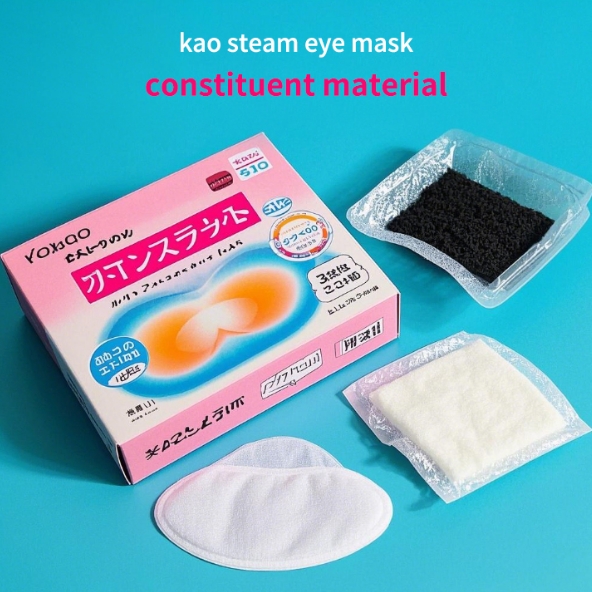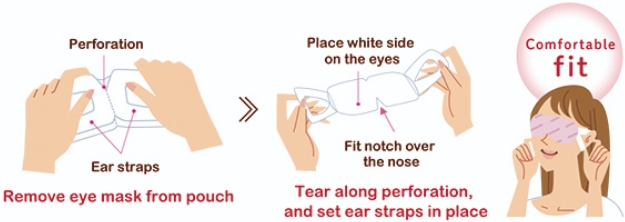Kao’s steam eye mask, especially the MegRhythm brand, has revolutionized personal care with its relaxing, heat-generating technology. If you’re involved in sourcing raw materials for steam eye masks, competing with Kao’s market dominance, or simply a consumer seeking to understand what goes into these soothing products, you’ve come to the right place. This article breaks down the types of Kao steam eye masks, how to use them, and a detailed analysis of their raw materials and structure.

Types of Kao Steam Eye Masks
Kao’s MegRhythm Steam Eye Mask line comes in several variants, each designed to offer a unique experience. Below are the primary types:
- Standard Steam Eye Mask: The most common version, offering soothing heat therapy for tired eyes.
- Lavender & Chamomile Steam Eye Mask: Infused with calming essential oils for a more aromatherapeutic experience.
- Warming Eye Mask for Night Use: Specifically designed to help improve sleep quality by providing gentle warmth for longer durations.
All of these masks share the same underlying technology: the ability to generate heat through a chemical reaction triggered by exposure to air. While each variant differs in fragrance or additional therapeutic benefits, the core raw materials remain quite similar.
How to Use Kao Steam Eye Masks
Using a Kao steam eye mask is simple. Here’s a quick guide:

- Remove the Mask from the Package: The mask is sealed in a plastic pouch to preserve its ingredients until use.
- Activate the Steam: As soon as the mask is exposed to air, a chemical reaction begins, producing heat and moisture.
- Wear the Mask: Place the mask over your eyes, adjust the straps for comfort, and let the warmth work its magic for approximately 10–20 minutes.
Key Raw Materials and Components of Kao Steam Eye Masks
Kao’s steam eye masks rely on a carefully selected mix of materials that generate heat, maintain comfort, and ensure effectiveness. Let’s break down these materials in detail.
| Material | Function | Description |
|---|---|---|
| Skin-side Nonwoven Fabric | Earloop and Outer layer, breathable comfort | Soft and breathable, nonwoven fabric allows air to flow through while holding the steam inside. This fabric is gentle on the skin, offering a comfortable experience. |
| Iron Powder | Heat generation | The primary heat-producing ingredient. When exposed to air, iron powder undergoes an oxidation reaction, producing heat that warms the mask and creates steam. |
| Magnesium and Salt | Reactants to trigger heat | Magnesium and salt enhance the oxidation reaction between iron powder and air, ensuring controlled heat release and effective steam production. |
| Activated Carbon | Moisture control, odor absorption | Helps regulate humidity and absorb excess moisture, keeping the mask dry and comfortable to wear. Activated carbon also prevents any unwanted odors. |
| Water | Facilitates the chemical reaction | Water plays a crucial role in the oxidation process, ensuring the reaction happens smoothly and consistently. |
| Essential Oils (optional) | Aromatherapy and fragrance | Kao often includes calming scents like lavender and chamomile to enhance the sensory experience. These oils provide a relaxing effect, improving sleep quality. |
| Plastic Film (Packaging) | Packaging and protection | The plastic film packaging ensures the mask remains sealed until activation, preserving the freshness and functionality of the ingredients inside. |
How These Materials Work Together
When the Kao steam eye mask is removed from its sealed packaging, the combination of iron powder, salt, and magnesium reacts with the air and water, releasing heat and steam. This process mimics a “self-heating” technology that doesn’t require an external power source. The activated carbon ensures moisture doesn’t accumulate in the mask, while the nonwoven fabric serves as a soft, breathable barrier, allowing you to comfortably wear the mask without irritation.
Raw Materials in the Steam Eye Mask Market: A Competitive Edge
For raw material suppliers, understanding the core components of Kao’s steam eye masks is critical. Here’s why these materials are so effective:
- Iron powder: Known for its efficiency and cost-effectiveness, iron powder provides a consistent heat output and can be sourced from various suppliers globally.
- Nonwoven fabrics: Versatile materials used widely in the textile and personal care industries, such as needle-punched nonwoven and polyester spunlace fabrics, offer both comfort and performance, making them ideal for applications like steam eye masks.
- Magnesium and salt: These are readily available, inexpensive ingredients that enhance the heat reaction and improve the mask’s overall performance.
For Kao’s competitors, understanding the balance of these materials is essential in designing steam eye masks that can match or exceed Kao’s quality, while still being cost-effective.
For consumers, knowing what goes into these masks allows you to make informed decisions based on factors such as sustainability, comfort, and effectiveness. The inclusion of natural essential oils or fragrances can also be a deciding factor for those seeking a more luxurious or relaxing experience.
Data and Reference Materials
To ensure the accuracy of the above analysis, we’ve sourced information from Kao’s official product descriptions, ingredient supplier reports, and independent consumer reviews.
- Kao MegRhythm Steam Eye Mask Ingredients: Kao’s official product website (https://www.kao.com/global/en/)
- Iron Powder and Chemical Reactions: Material Safety Data Sheets (MSDS) for Iron Powder from leading suppliers.
- Nonwoven Fabrics for Personal Care: Reports from the Nonwoven Fabric Manufacturers Association (https://www.nfpa.com)
